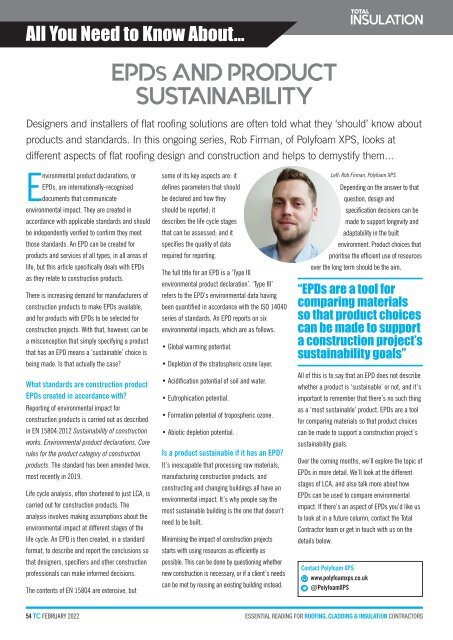February 2022
You also want an ePaper? Increase the reach of your titles
YUMPU automatically turns print PDFs into web optimized ePapers that Google loves.
All You Need to Know About...<br />
EPDS AND PRODUCT<br />
SUSTAINABILITY<br />
Designers and installers of flat roofing solutions are often told what they ‘should’ know about<br />
products and standards. In this ongoing series, Rob Firman, of Polyfoam XPS, looks at<br />
different aspects of flat roofing design and construction and helps to demystify them...<br />
Environmental product declarations, or<br />
EPDs, are internationally-recognised<br />
documents that communicate<br />
environmental impact. They are created in<br />
accordance with applicable standards and should<br />
be independently verified to confirm they meet<br />
those standards. An EPD can be created for<br />
products and services of all types, in all areas of<br />
life, but this article specifically deals with EPDs<br />
as they relate to construction products.<br />
There is increasing demand for manufacturers of<br />
construction products to make EPDs available,<br />
and for products with EPDs to be selected for<br />
construction projects. With that, however, can be<br />
a misconception that simply specifying a product<br />
that has an EPD means a ‘sustainable’ choice is<br />
being made. Is that actually the case?<br />
What standards are construction product<br />
EPDs created in accordance with?<br />
Reporting of environmental impact for<br />
construction products is carried out as described<br />
in EN 15804:2012 Sustainability of construction<br />
works. Environmental product declarations. Core<br />
rules for the product category of construction<br />
products. The standard has been amended twice,<br />
most recently in 2019.<br />
Life cycle analysis, often shortened to just LCA, is<br />
carried out for construction products. The<br />
analysis involves making assumptions about the<br />
environmental impact at different stages of the<br />
life cycle. An EPD is then created, in a standard<br />
format, to describe and report the conclusions so<br />
that designers, specifiers and other construction<br />
professionals can make informed decisions.<br />
The contents of EN 15804 are extensive, but<br />
some of its key aspects are: it<br />
defines parameters that should<br />
be declared and how they<br />
should be reported; it<br />
describes the life cycle stages<br />
that can be assessed; and it<br />
specifies the quality of data<br />
required for reporting.<br />
The full title for an EPD is a ‘Type III<br />
environmental product declaration’. ‘Type III’<br />
refers to the EPD’s environmental data having<br />
been quantified in accordance with the ISO 14040<br />
series of standards. An EPD reports on six<br />
environmental impacts, which are as follows.<br />
• Global warming potential.<br />
• Depletion of the stratospheric ozone layer.<br />
• Acidification potential of soil and water.<br />
• Eutrophication potential.<br />
• Formation potential of tropospheric ozone.<br />
• Abiotic depletion potential.<br />
Is a product sustainable if it has an EPD?<br />
It’s inescapable that processing raw materials,<br />
manufacturing construction products, and<br />
constructing and changing buildings all have an<br />
environmental impact. It’s why people say the<br />
most sustainable building is the one that doesn’t<br />
need to be built.<br />
Minimising the impact of construction projects<br />
starts with using resources as efficiently as<br />
possible. This can be done by questioning whether<br />
new construction is necessary, or if a client’s needs<br />
can be met by reusing an existing building instead.<br />
Left: Rob Firman, Polyfoam XPS.<br />
Depending on the answer to that<br />
question, design and<br />
specification decisions can be<br />
made to support longevity and<br />
adaptability in the built<br />
environment. Product choices that<br />
prioritise the efficient use of resources<br />
over the long term should be the aim.<br />
“EPDs are a tool for<br />
comparing materials<br />
so that product choices<br />
can be made to support<br />
a construction project’s<br />
sustainability goals”<br />
All of this is to say that an EPD does not describe<br />
whether a product is ‘sustainable’ or not, and it’s<br />
important to remember that there’s no such thing<br />
as a ‘most sustainable’ product. EPDs are a tool<br />
for comparing materials so that product choices<br />
can be made to support a construction project’s<br />
sustainability goals.<br />
Over the coming months, we’ll explore the topic of<br />
EPDs in more detail. We’ll look at the different<br />
stages of LCA, and also talk more about how<br />
EPDs can be used to compare environmental<br />
impact. If there’s an aspect of EPDs you’d like us<br />
to look at in a future column, contact the Total<br />
Contractor team or get in touch with us on the<br />
details below.<br />
Contact Polyfoam XPS<br />
www.polyfoamxps.co.uk<br />
@PolyfoamXPS<br />
54 TC FEBRUARY <strong>2022</strong>

















